And so do trail runners, who flock to this venue every January in
increasing numbers to challenge themselves over 25, 50, or 100 kilometers in
Tejas Trails' difficult -- and very popular -- Bandera footraces.
What experienced trail runner can resist a race motto that proclaims,
"A trail run of rugged and brutal beauty, where everything cuts, stings,
or bites?"
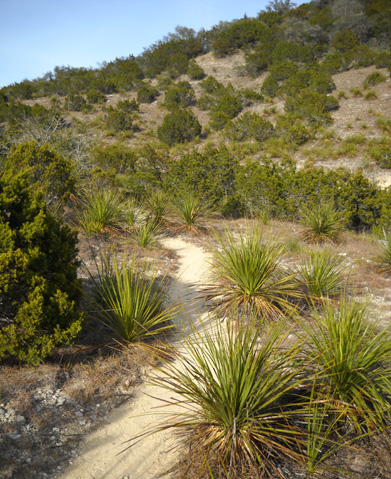
Don't run into the ubiquitous Texas Sotol; it will cut you
up.
Neither Jim nor I have ever been to Bandera, the nearby natural area, or
this event before.
The location and timing work well for Jim to use
the 50K as a long training run a month before the Rocky Raccoon 50-miler
in Huntsville, TX but he put off entering Bandera until he could see
whether he could train adequately for it. He's been having problems with
a chronic case of plantar faciitis for about six months and unable to
run much.
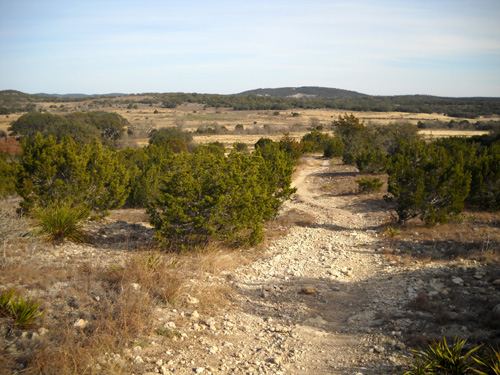
It was pretty obvious in December that running a gnarly race like
Bandera wasn't in Jim's best interest, even if it was for "only" thirty-one
miles. He was still interested in checking out the event for future years,
however. So he wrote to Race Director Joe Prusaitis several weeks before the race to
volunteer our services and ask about camping. That way we could still get a
feel for the event and check out parts of the course.
Unfortunately, at that time we had no clue that we'd be camping in
conditions more frigid than we've ever camped before! We kept our promise even
when we saw it coming, however.
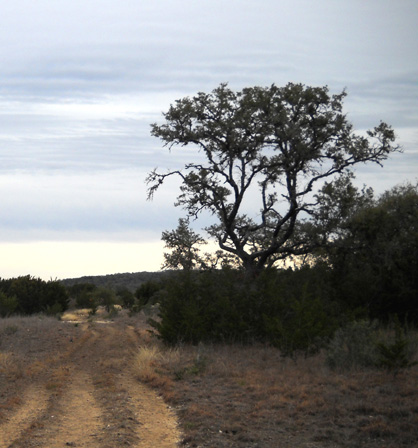
The gray sky makes it feel even colder.
Joe assigned us to work the very busy Crossroads Aid Station during the
races. The aid station is located at one of the equestrian campgrounds in the
natural area. Joe
assured us that we could stay there for several days since Jim also volunteered
to help set up aid stations and do other pre-race activities on Wednesday,
Thursday, and Friday.
The race organization pretty much has the whole natural
area reserved all weekend -- the small group lodge, campgrounds, and aid station
locations. Other folks could come in to ride or hike or camp in the
back-country, but with over 600 runners on the trails all day Saturday and into
the night, their ride or hike would be anything but secluded.
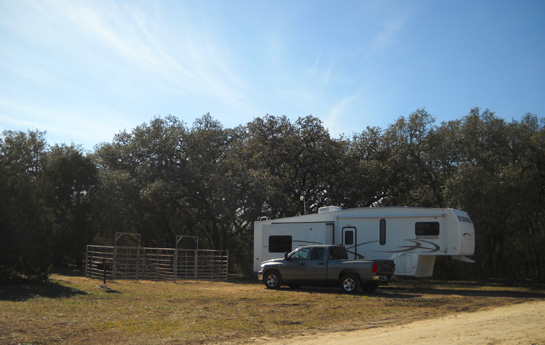
Our campsite in the equestrian campground
The HSCNA is well-suited for equestrians; trail riding is
even more popular here than hiking and running. Although there are a few sites
with electricity and water near the lodge for non-equestrian overnight RV camping,
most of the campsites in the natural area are designed for equestrians. As you
can see at our site above, there is a
small corral for horses. Water is available nearby. A picnic table and fire
ring are hidden behind our camper.
Our campground at the location of the Crossroads AS is called
the Trailhead Equestrian Camp Area on the park
map. It has only six campsites
and no water or electrical hookups so we're using our boon-docking power sources: generator, propane, and solar.
We are staying in the site our aid station captain
recommended for four nights. It is more than convenient -- it's only a
few feet away from the aid station!
That's mostly a good thing.
You can see our HitchHiker below; the aid station will be set up to
the right, where the
tents and other pieces of equipment are lying in the background below:
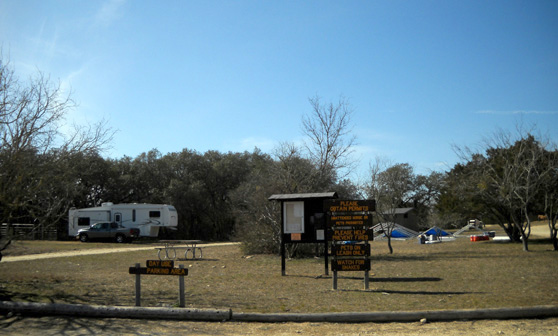
Although we don't have the best Verizon signal (and it's extended
network) out here in the boonies, we are very surprised we have any cell
service at all -- and TV reception! We've been in more populated areas
with no TV signals. We're glad to have internet and TV access for weather
reports and other news.
Two fellas and their horses who were camped nearby when we arrived on
Wednesday left on Friday just before more race volunteers came in to use
their site. Their combination horse-people trailer is behind the
bathroom in the next photo, which also shows the framing for some of our
aid station tents:

I enjoyed watching the horses and wished I could go on a trail ride
since I can't run long distances any more! I could have seen more of the
trails that way.
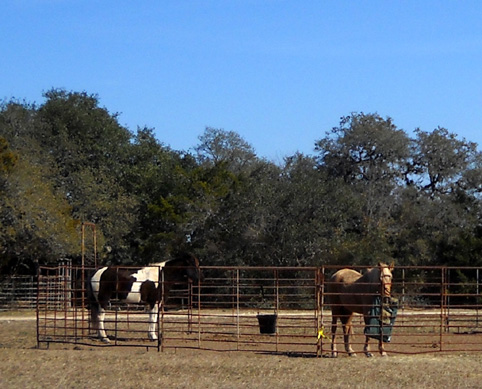
I'll talk about the race in the next entry dated January 10. In this one, I'll focus on the
recreational opportunities in the natural area, the trails I was able to
explore this week (this page), and our pre-race volunteer activities (page 2).
KEEPING IT WILD
The Hill Country State Natural Area covers about 5,400 acres ten miles west
of the town of Bandera. It was acquired by
the state of Texas in 1976 and opened to the public in 1984. According to the
state park
website, "The bulk of the site was a
donation from the Merrick Bar-O-Ranch with the stipulation that it be kept far
removed and untouched by modern civilization, where everything is preserved
intact, yet put to a useful purpose."
That goal appears to have been met. Even though I didn't range more than
two miles from our campsite on the trails, I felt like I was in the
middle of nowhere. I like that!
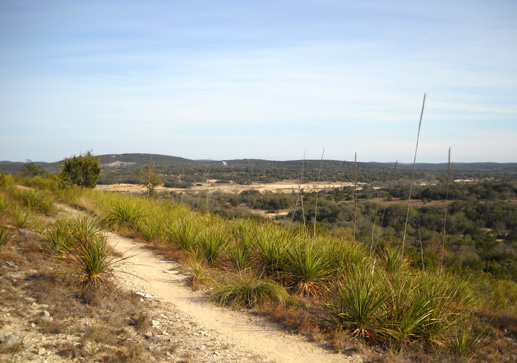
Overnight accommodations are rustic: choices are staying inside
a small group lodge, camping on grass in a tent or any type of RV, or
primitive back-country camping.
Recreational activities focus on the 40-mile network of multi-use trails
weaving through rugged terrain. Visitors can enjoy backpacking, hiking,
running, mountain biking, riding horses, observing birds and other
wildlife, and limited fishing and swimming in various spots along
spring-fed West Verde Creek. Several nearby ranches offer horse rentals,
tours, and other accommodations throughout the natural area.
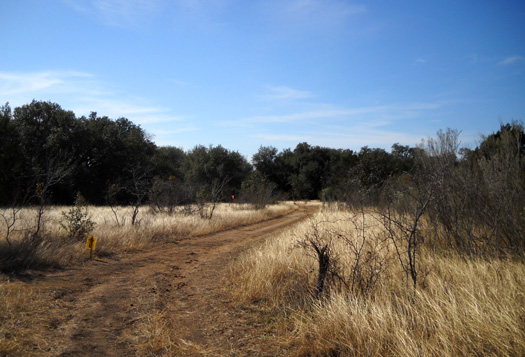
Above and below: the beginning of the five-mile
loop out of Crossroads AS in the 50K and 100K
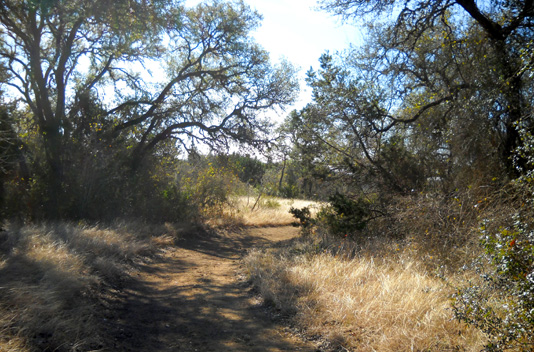
If you come to HCSNA to hike, run, or ride a bike or horse be aware that the terrain features a variety of
rocky hills, flowing springs and creeks to cross, shady oak groves, open
grasslands, and scenic canyons. Some trails are wide and smooth for a while,
like those above;
others are rocky and narrow and climb through short but steep canyons (below) up to 2,000 feet in
elevation.
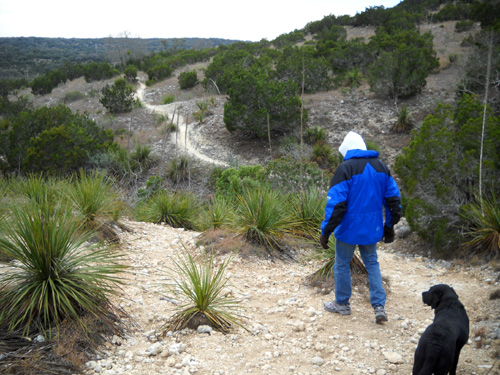
Besides the limited trail photos shown here, check out the
race
website for more
pictures of the race course.
I got out for several
hikes with Cody and/or Jim but didn't range more than a couple miles out in
several directions. I'm more of a weather
weenie since I'm doing more waking than running now. I just don't enjoy walking in
cold, windy, or wet weather
because I can't generate as much body heat as I could when I ran. It's also
not easy for me to negotiate rough or steep trails any more; I "ran into"
those within half a mile of our campsite.
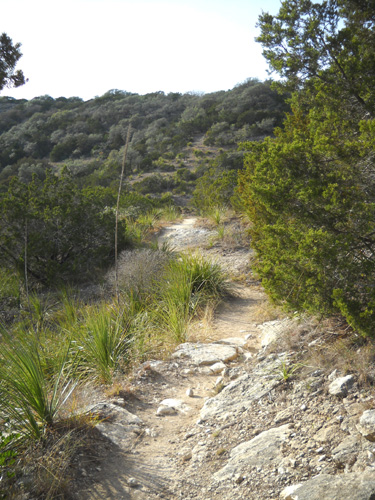
Jim was so busy helping Henry Hobbs, Mark "Crash" Johnson, and other core volunteers
set up the aid stations in the days leading up to the race that he didn't have
much time to run or hike. Besides, many of the trails at HCSNA aren't exactly
conducive to healing his foot injury. Hopefully he'll be over the PF soon and can
resume training as much as he wants.
FLORA AND FAUNA
Large numbers of birds live in the park, especially in the winter, although
I didn't see or hear nearly as many as I did in the Sonoita Creek State Natural
Area in southeast Arizona. As cold
as it's been this winter in southern Texas, I'm guessing some of them wish they'd
migrated farther south! (So do we.)
Deer, wild boars, armadillos, raccoons,
ringtail cats, rabbits, rodents, and various reptiles can also be
viewed. I saw deer, rabbits, mice, and squirrels on my hikes but no armadillos,
boars,
or ringtail cats. It was probably too cold for any rattlesnakes or lizards to be out and
about.
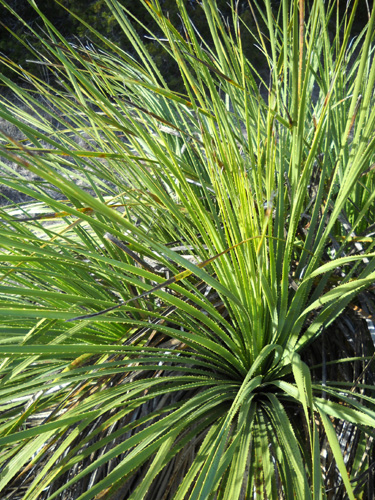
Texas Sotol is very common in the natural area.
Like the Sonoita Creek State Natural Area in Arizona, several different plant communities
are represented in the Hill Country SNA. Just within a couple
miles of our campground I observed grasslands, pine trees and oak groves, and
rocky hills and canyons with more desert-like plants.
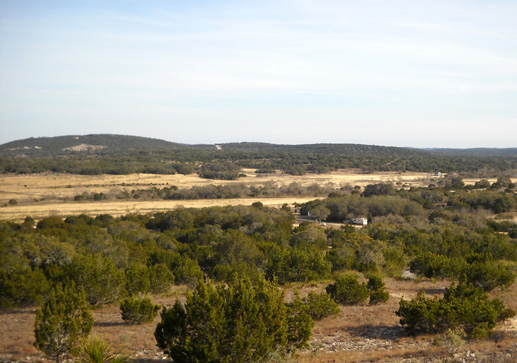
There are scenic vistas from all of the high points in the natural area. I
hope the runners look UP enough during the race to see some of the scenery.
Continued on
page 2 . . .
Happy trails,
Sue
"Runtrails & Company" - Sue Norwood, Jim O'Neil,
and Cody the Ultra Lab
Previous
Next
© 2010 Sue Norwood and Jim O'Neil